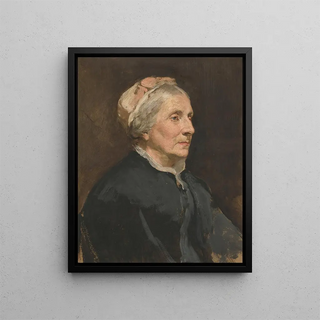Art print Portrait of an elderly woman - Edwin Austin Abbey | Art print


View from behind

Frame (optional)
In the vast panorama of art history, certain artworks stand out for their ability to capture the very essence of humanity. "Art print of an elderly woman - Edwin Austin Abbey" is one of those creations that transcends the simple frame of a canvas to invite the viewer to a profound reflection on the passage of time and the beauty of age. This portrait, imbued with rare delicacy, immerses us in the intimacy of a lived life, revealing through its features marked by time a silent wisdom and a rich personal story. Every gaze cast upon this piece becomes an exploration of human emotions, a journey through memories and experiences that shape an existence.
Style and uniqueness of the work
Edwin Austin Abbey's style is characterized by finesse of execution and meticulous attention to detail. In "Art print of an elderly woman," the artist manages to combine realism and lyricism, creating an almost tangible atmosphere. The nuances of colors used, ranging from warm tones to deeper shadows, confer emotional depth to the composition. The woman's face, delicately lit, seems to tell a story, each wrinkle and expression reflecting a life rich in experiences. Abbey does not merely depict a figure; he immortalizes an essence, a humanity that resonates with anyone who takes the time to contemplate his work. This portrait is not just an image but a dialogue between the artist and the viewer, an invitation to question the meaning of life and identity.
The artist and his influence
Edwin Austin Abbey, an emblematic figure of the Pre-Raphaelite movement, demonstrated throughout his career his mastery in portrait art. His ability to marry tradition and innovation marked his era and continues to influence many contemporary artists. Abbey, through his unique approach and sensitivity to the human condition, captured the attention of a broad audience, appealing to both art enthusiasts and critics. His work, which combines refined technique with psychological depth, has elevated the portrait to a level of emotional intensity rarely achieved. Focusing on faces and

Matte finish

View from behind

Frame (optional)
In the vast panorama of art history, certain artworks stand out for their ability to capture the very essence of humanity. "Art print of an elderly woman - Edwin Austin Abbey" is one of those creations that transcends the simple frame of a canvas to invite the viewer to a profound reflection on the passage of time and the beauty of age. This portrait, imbued with rare delicacy, immerses us in the intimacy of a lived life, revealing through its features marked by time a silent wisdom and a rich personal story. Every gaze cast upon this piece becomes an exploration of human emotions, a journey through memories and experiences that shape an existence.
Style and uniqueness of the work
Edwin Austin Abbey's style is characterized by finesse of execution and meticulous attention to detail. In "Art print of an elderly woman," the artist manages to combine realism and lyricism, creating an almost tangible atmosphere. The nuances of colors used, ranging from warm tones to deeper shadows, confer emotional depth to the composition. The woman's face, delicately lit, seems to tell a story, each wrinkle and expression reflecting a life rich in experiences. Abbey does not merely depict a figure; he immortalizes an essence, a humanity that resonates with anyone who takes the time to contemplate his work. This portrait is not just an image but a dialogue between the artist and the viewer, an invitation to question the meaning of life and identity.
The artist and his influence
Edwin Austin Abbey, an emblematic figure of the Pre-Raphaelite movement, demonstrated throughout his career his mastery in portrait art. His ability to marry tradition and innovation marked his era and continues to influence many contemporary artists. Abbey, through his unique approach and sensitivity to the human condition, captured the attention of a broad audience, appealing to both art enthusiasts and critics. His work, which combines refined technique with psychological depth, has elevated the portrait to a level of emotional intensity rarely achieved. Focusing on faces and
12,34 €






